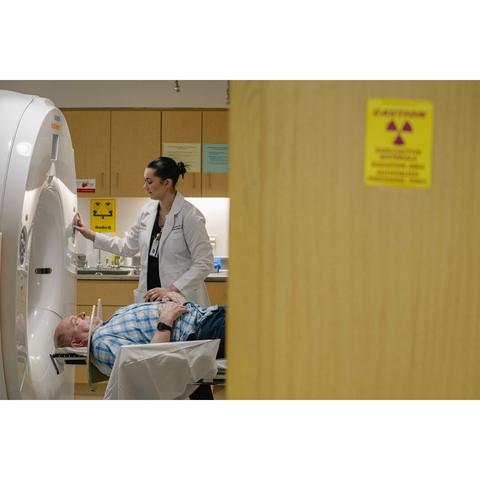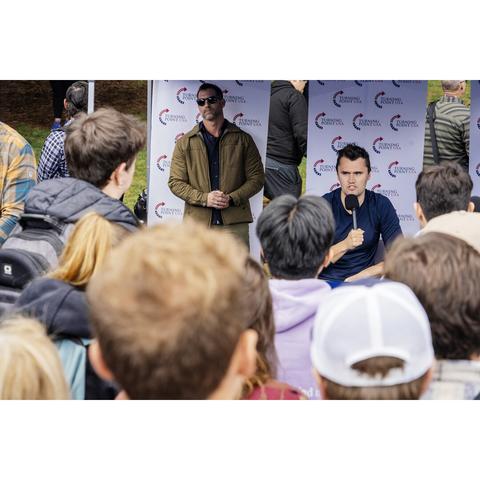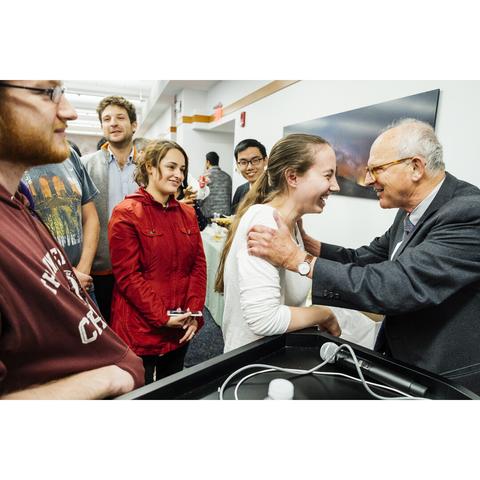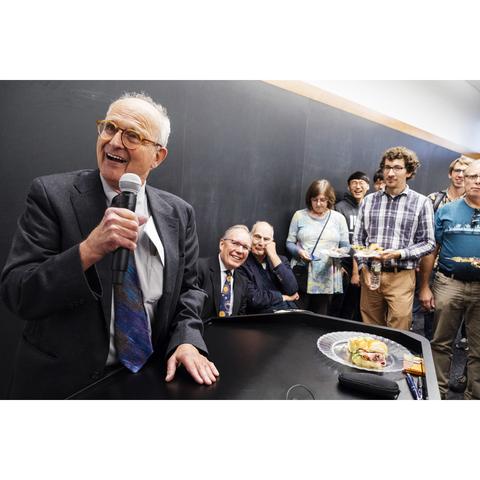I spent a few days earlier this year in rural Washington state and St. Louis, Missouri, for a New York Times story on Doug Whitney, a man who should have died two decades ago from early-onset Alzheimer's Disease, but somehow hasn't developed any symptoms. His mother was one of 10 siblings, out of 13, in her family who died from the disease; the family carries a genetic mutation that makes them more likely to develop early-onset Alzheimer's. Doug, now in his mid-70s, is the only known person in the world to have the mutation and not have symptoms of the disease, which usually present before one reaches mid-50s. Since discovering his genetic predisposition to the disease, he has been studied by researchers at Washington University in St. Louis, allowing doctors to poke, prod, scan, and do everything they need to figure out why he hasn't developed Alzheimer's. At his home, he sat with wife Ione and worked on jigsaw puzzles while I visited. In St. Louis, he underwent MRI and PET
scans, a spinal tap, blood draws, and other mental and physical examinations that he has been doing annually so the researchers can add to their long-term record of his genetics, physiological characteristics, and mental capabilities as he ages. One particular avenue of recent investigation is a significant build-up of heat-stress proteins in his brain possibly from his years working as a Navy mechanic, which some believe may make Doug less susceptible to the development of tau tangles in the brain, a hallmark of Alzheimer's disease. It was great to work so closely with Pulitzer-winning reporter Pam Belluck on this, whose health reporting I've sought out over the years.
A big thanks to Matt for the call on this assignment and for big play in the paper and online (with some video!)
#photography #photojournalism #news #health #science #onassignment #alzheimersdisease
#onassignment
Charlie Kirk made one of his "Prove Me Wrong" stops in May 2024 at the University of Washington campus in Seattle as part of his Live Free Tour across the country as the national presidential race was really getting underway before the summer's conventions. He was surrounded by a handful of bodyguards at all times during the event. I was there covering the ongoing pro-Palestine encampment nearby on the campus for the New York Times and decided to go a little early to photograph a bit of Kirk's visit that day. The photos have been resurfacing over the last week with NYT stories after Kirk's apparent assassination during a similar event in Utah. One of the Turning Point USA buttons that they were giving away that day in Seattle read "Stick to your guns / If you're not strapped Big Gov will be."
#photography #photojournalism #seattle #news #politics #onassignment #charliekirk #journalism
#photography #photojournalism #seattle #news #politics #onassignment #charliekirk #journalism
From the mile-long river to the iron arcs, Pittsburgh speaks in bridges and light. I photograph to remind myself that moments pass in a blink—be present, be grateful, and tell your loved ones you care about them. Today is a gift.
#Pittsburgh #BridgeCity #TodayIsAGift #Gratitude #MorningLight #PittsburghPhotography #UrbanPhotography #BridgePhotography #CandidMoments #ChasingMoments #OnAssignment #LoveYourPeople #GratefulHeart
MIT physicist and 2017 Nobel prize winner Rainer Weiss died this week. I photographed him at home as he learned he won the award for his work detecting gravitational waves with the LIGO system he developed. Later in the day, he spoke at MIT about his research and celebrated the prize with scientific collaborators, students, and the MIT community. It was such a whirlwind, but the things I'll always remember is his wife Rebecca (seen looking in as he receives THE phone call in the first image) offering me toast as we all waited for the news so early in the morning and Rainer's infectious energy and friendliness. During one of his speeches, he told the story about how he dreamed up the idea for the gravitational wave detectors but that everyone he told about it thought he was crazy and wrote off his ideas for decades. Eventually the idea turned into reality and became the largest project funded by the National Science Foundation (and other organizations). In the first 10 or so years, no
gravitational waves were detected, but after the 2015 completion of five-year project to increase the sensitivity of its measurements, the system worked, providing the first measurable evidence that confirmed this part of Einstein's theory of general relativity, almost exactly 100 years after the theory was first presented. The research paper was published in 2016, and he won the award in 2017.
#photography #onassignment #history #physics #science #photojournalism #mit #boston #scientist #nobelprize
gravitational waves were detected, but after the 2015 completion of five-year project to increase the sensitivity of its measurements, the system worked, providing the first measurable evidence that confirmed this part of Einstein's theory of general relativity, almost exactly 100 years after the theory was first presented. The research paper was published in 2016, and he won the award in 2017.
#photography #onassignment #history #physics #science #photojournalism #mit #boston #scientist #nobelprize
I've added a new story to my website, an extended look at the story I photographed for High Country News last summer (and published in the magazine in April) on the MYWY program for adopting and training wild mustangs in Washington state. Here are a few favorite outtakes that didn't make it into the magazine, but which you can see on my website. Thanks again to Bear for the challenging assignment!
Link: https://www.mscottbrauer.com/to-train-mustang/
#photojournalism #documentary #horses #pnw #pacificnorthwest #washingtonstate #wa #photography #onassignment #documentaryphotography #journalism
Link: https://www.mscottbrauer.com/to-train-mustang/
#photojournalism #documentary #horses #pnw #pacificnorthwest #washingtonstate #wa #photography #onassignment #documentaryphotography #journalism
Shipping containers at the Port of Seattle yesterday, including quite a few from Chinese logistics companies COSCO and China Shipping, as the Trump administration's on-again-off-again tariff threats got delayed by another 90 days.
#seattle #trade #globaltrade #politics #shipping #photojournalism #onassignment #industry #industrial #tariff #politics #business
#seattle #trade #globaltrade #politics #shipping #photojournalism #onassignment #industry #industrial #tariff #politics #business
For CascadePBS' Black Arts Legacies, we profiled print artist Jite Agbro as she created multi-layered pieces that are almost like collages of etching, sewing, and monotype, in her studio in Seattle's Fremont neighborhood. Again, I helped produce the still portion of the piece for photographer Meron Menghistab (seen in image 3) and did some behind-the-scenes and detail photography. This was the fifth and final season of the series profiling living and dead Black artists who have contributed to the vibrant Seattle arts scene. Articles, videos, and photos from this and the previous seasons can be seen on the BAL and CascadePBS websites. I'm very glad to have contributed a small part to the project. Kudos to the rest of the team, many of whom worked on all five seasons, for creating such an expansive look at the history and current trajectory of Seattle's Black artists.
#seattle #arts #artist #pnw #pacificnorthwest #photojournalism #documentary #visualarts #onassignment #editorial #portrait #portraiture
#seattle #arts #artist #pnw #pacificnorthwest #photojournalism #documentary #visualarts #onassignment #editorial #portrait #portraiture
As the sun sets in Portland, Maine. #OnAssignment
For CascadePBS' Black Arts Legacies, we profiled playwright and performer Andrew Lee Creech rehearsing monologues his plays in a practice space at Seattle's ACT Contemporary Theatre. I helped produce the stills portion of the shoot for photographer Meron Menghistab (seen in image 3) and photographed some details and behind-the-scenes images to fill out the final profile. Alll five seasons of the project are available on the Black Arts Legacies and CascadePBS websites.
#seattle #arts #theater #theatre #photography #onassignment #photojournalism
#seattle #arts #theater #theatre #photography #onassignment #photojournalism
Behind the scenes with the recent Doris Duke Artist Award recipient and Grammy-nominated musician Kassa Overall during a photoshoot for the CascadePBS series Black Arts Legacies at his backyard studio. I helped produce the shoot for photographer Meron Menghistab, who has photographed all seasons of Black Arts Legacies, alongside Genna Martin and the rest of the BAL team. On the web (and broadcast, I believe) today.
#photography #photojournalism #music #musician #portrait #portraiture #seattle #onassignment #pacificnorthwest
#photography #photojournalism #music #musician #portrait #portraiture #seattle #onassignment #pacificnorthwest
I spent a quick afternoon at Funko headquarters in Everett, Washington, with CEO Cynthia Williams, who's been at the company's helm for about a year after serving as president of Wizards of the Coast, where she oversaw Magic: The Gathering and Dungeons and Dragons. Funko, of course, is the manufacturer of Funko Pop! figurines, large-headed cartoony toys in the shapes of characters from just about every entertainment franchise and the worlds of music and sports. For WSJ, published over the weekend. A big thanks to Jenny for the call!
#fandom #funko #photography #photojournalism #portrait #portraiture #onassignment #editorial #pacificnorthwest #everett
#fandom #funko #photography #photojournalism #portrait #portraiture #onassignment #editorial #pacificnorthwest #everett
In late April, Pike Place Market started a partial car-free pilot program on the streets outside the iconic Seattle landmark, something many locals have been advocating for years. The temporary street closure still allows vendors, those with handicap placards, and curbside pickups, to drive along Pike Place. The vendors I spoke with, including Troy Terry (image 5), who makes a daily delivery stop at the market for Ocean Beauty Seafoods, like the change, but have complained that they have to approach Pike Street from the north under the new program rather than turning left from 1st Avenue to enter the market. "So far it's easier," he said of the program, "There's a place to park [a large delivery truck]." Since the start of the program, the market has installed more picnic tables and seating on the street, and pedestrians seem to be taking the cue. For CascadePBS.
#seattle #pikeplacemarket #tourism #photojournalism #photography #streetphotography #onassignment #pacificnorthwest #pnw
#seattle #pikeplacemarket #tourism #photojournalism #photography #streetphotography #onassignment #pacificnorthwest #pnw
Seattle city council member Dan Strauss has proposed a bill that would require venues with loud music to provide free or cheap earplugs to concertgoers. For CascadePBS and KNKX I went to Fremont's Add-A-Ball to see what music fans thought of the proposal at an album release show for Fluung with openers Waltzerr and Letterbomb. Most people said they already bring their own earplugs and the venue already had earplugs available for 50 cents. The musicians we spoke with said hearing protection is important but they wished the city council would do something to make it easier for musicians and artists to survive and thrive in Seattle.
#seattle #pnw #pacificnorthwest #music #photojournalism #photography #onassignment #nightlife
#seattle #pnw #pacificnorthwest #music #photojournalism #photography #onassignment #nightlife
Shipping containers at the Port of Seattle recently for a CascadePBS story about how the ongoing tariff war will affect businesses in Washington state.
#photography #photojournalism #industrial #seattle #port #onassignment #pacificnorthwest #business
#photography #photojournalism #industrial #seattle #port #onassignment #pacificnorthwest #business
Kitty Dukakis, the former first lady of Massachusetts, died last week at age 88. In 2016 I photographed her, and husband former governor and Democratic presidential nominee Michael Dukakis, at their home in Brookline, Mass., for a New York Times story about electroconvulsive therapy (formerly known as electroshock therapy). Kitty said that the treatment was instrumental in her overcoming alcoholism and had become an evangelist for the procedure. I visited one of the weekly ECT support groups that the couple held at their home and we joked about the turkey carcasses that Michael famously collected from friends every year after Thanksgiving to make broth. One of the portraits I took was in the NYT obituary published in Sunday's print edition.
#photojournalism #politics #obituary #onassignment #tearsheet #massachusetts #boston
#photojournalism #politics #obituary #onassignment #tearsheet #massachusetts #boston
Three years ago today, the US awoke to news that Russia had invaded Ukraine after weeks of increasing aggression. A small group of Ukrainians and Eastern Europeans gathered outside the Massachusetts State House in Boston in one of the first public shows of opposition in the US after the invasion began. I especially remember Iryna (last image) tearfully speaking with her mother in Ukraine and discussing a rumor that Russian forces had just taken hold of Chernobyl. Photographed for NYT.
#photojournalism #photography #news #ukraine #war #onassignment #boston #massachusetts #standwithukraine
#photojournalism #photography #news #ukraine #war #onassignment #boston #massachusetts #standwithukraine
A few minutes with Kayla, a Drone Integration Engineer at Amazon's Prime Air, photographed recently for Amazon. Her job is making sure the software and hardware systems all communicate with one another.
#photography #portrait #portraitmood #portraiture #commercialphotography #commercialphotographer #science #scientist #onassignment
#photography #portrait #portraitmood #portraiture #commercialphotography #commercialphotographer #science #scientist #onassignment
Washington state inaugurated a new governor last month, former Attorney General Bob Ferguson. His inaugural address focused on the state's gubernatorial history and his vision for the future. Immediately after speaking, he went to the Governor's office in the Capitol building and signed three executive orders focusing on the cost of housing and protecting reproductive freedom. For Cascade PBS.
#photography #photojournalism #onassignment #politics #olympia #pacificnorthwest #washingtonstate
#photography #photojournalism #onassignment #politics #olympia #pacificnorthwest #washingtonstate
Tulsi Gabbard was just confirmed as Director of National Intelligence, with a lone Republican voting against. I was reminded of photographing her unsuccessful 2020 presidential campaign, when she was a Democrat, and this very strange campaign stop, in which supporters said media organizations were conspiring to keep her out of the race. Gabbard was supposed to speak at the event (see unused mic in the first image), and rumors were flying that she was hanging out in a nearby RV, but she never showe, the RV left the scene, and everyone packed up their signs.
#photography #photojournalism #politics #onassignment #newhampshire
#photography #photojournalism #politics #onassignment #newhampshire
⛵❄️ Sailing Expedition to Svalbard – An Arctic Adventure ❄️🏔️
Sailing through the icy waters of Svalbard, we explored one of the most remote and breathtaking regions on Earth. From the deck of our ship, we watched glaciers carve their way into the sea and ventured ashore on snowshoe hikes through the frozen landscape. Along the way, we encountered Arctic wildlife—reindeer, foxes, and even massive elephant seals. 🦊🦭🦌
An unforgettable journey through ice and wilderness, where the silence of the Arctic and the vastness of nature made every moment special.
📸 Swipe through to see the highlights of this unique experience!
#SvalbardExpedition #ArcticSailing #IntoTheWild #FrozenNorth #NatureAtItsBest #WildlifePhotography #LandscapePhotography #AdventurePhotography #ArcticExplorer #WildernessCulture #OnAssignment #TravelPhotography #ExpeditionPhotography #SailingPhotography #ColdLands #IceAndSnow
Sailing through the icy waters of Svalbard, we explored one of the most remote and breathtaking regions on Earth. From the deck of our ship, we watched glaciers carve their way into the sea and ventured ashore on snowshoe hikes through the frozen landscape. Along the way, we encountered Arctic wildlife—reindeer, foxes, and even massive elephant seals. 🦊🦭🦌
An unforgettable journey through ice and wilderness, where the silence of the Arctic and the vastness of nature made every moment special.
📸 Swipe through to see the highlights of this unique experience!
#SvalbardExpedition #ArcticSailing #IntoTheWild #FrozenNorth #NatureAtItsBest #WildlifePhotography #LandscapePhotography #AdventurePhotography #ArcticExplorer #WildernessCulture #OnAssignment #TravelPhotography #ExpeditionPhotography #SailingPhotography #ColdLands #IceAndSnow
Client Info
Server: https://mastodon.social
Version: 2025.07
Repository: https://github.com/cyevgeniy/lmst
























